My tried and true recipe for a classic Italian Meat Sauce, great on top of pasta or in lasagna or other baked pastas, such as manicotti.
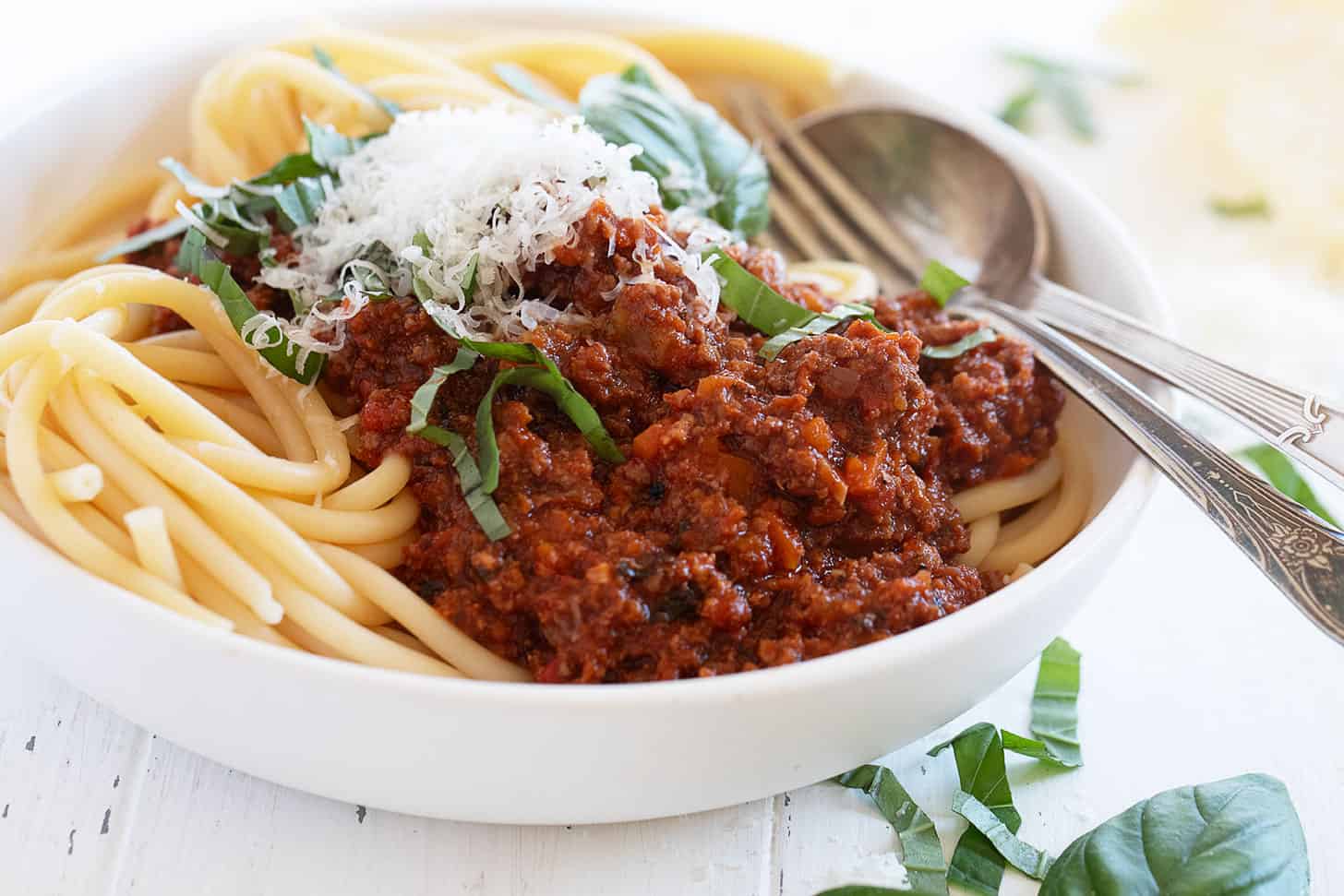
I have been making Italian Meat Sauce for a lot of years, but it occurred to me recently that these are just the sort of recipes that I should take the time to “write down” here. Even basic, classic dishes like meat sauce need a recipe to start with.
This meat sauce is perfect to top pasta, or for lasagna or to stuff meat manicotti. It’s a classic, long-simmering meat sauce, flavoured with a bit of red wine, lots of garlic, carrot, onion and herbs. At the end, a bit of butter and a touch of cream is stirred in, to finish.
This is not a bolognese sauce, although I often here that term used to describe any sort of Italian meat sauce. I believe authentic bolognese has a lot of milk and wine in it and is actually quite light on the tomatoes. Italian Meat sauce is really just Italian tomato sauce … with meat :) Maybe the term ragu might be somewhat appropriate, but I don’t have an Italian nonna, so maybe not. It’s just darned good with pasta, whatever you want to call it.
Ingredients and substitutions
A few notes about the key ingredients …
Ground Beef: You can use whatever fat content of ground beef you like here. You’ll note that in the recipe, most of the fat will be spooned off after browning anyway. If you like, you can use a mix of ground beef and ground pork here, or use a classic mix of ground beef, pork and veal.
Red Pepper Flakes: If you like a touch of “warmth” in your sauce, add a pinch of red pepper flakes with your garlic, adjusting amount to taste. I find a pinch is about all I need, unless I’m aiming for a particularly spicy sauce, for some reason.
Canned Tomatoes: Use whatever canned tomatoes you like or prefer, but I always start with whole tomatoes, that I hand crush before adding to the pot. You could use diced or even crushed tomatoes, if that’s all you have on hand.
Tomato Paste: There isn’t a lot of tomato paste in the sauce, but it does play an important role in the rich tomato taste of the finished sauce. I find the tubes of tomato paste handy for these small amounts, so I don’t have to open up a can and then deal with the leftovers.
Garlic: You can’t beat fresh garlic in pasta sauces like this, so that would be recommended. Adjust the amount of garlic to your taste (or your family’s).
Tip! You don’t always have to mince garlic. I like to thinly slice it for dishes like this meat sauce. It’s much less prone to scorching in larger pieces and scorched garlic is definitely something I want to avoid, as it becomes quite bitter in the sauce. Don’t worry about the larger chunks being too strong in the end. After a couple of hours of simmering, it’s quite mild.
Red Wine: The red wine adds both great flavour and a bit of acidity to the sauce. If you don’t have or want to use red wine, add a splash of red wine vinegar to deglaze the pan, instead of the wine. You may need to add a touch more liquid to the pot to replace the wine.
Carrots – I remember when I first made a meat sauce like this, being surprised that the carrots somehow managed to hold their shape through 2 1/2 hours of simmering. But indeed they do. So keep that in mind when you are cutting them up and keep them small. I will often pull out my immersion blender and give my sauce the tiniest blitz to blend the onions and carrots into the sauce. I just like the smoother sauce. It’s just personal preference and definitely not necessary. Just use a really light hand. You definitely don’t want to go overboard on the blending. Literally 2 or 3 pulses will do it. It’s also a great trick if you have kids that will spot the carrots and then won’t eat it :)
Recipe tips!
- Be sure to spoon off most of the fat/liquid after browning the ground beef and then continue cooking the now-dry-ish ground beef a little longer, to develop a little more flavour from extra browning of both the meat and some brown bits on the bottom of the pot.
- Speaking of the pot, start with your heaviest-bottom pot. As this is a long-simmering sauce, a heavy-bottomed pot will help to avoid scorching as the sauce thickens.
- Be sure to check/stir regularly towards the end of cooking, as the sauce thickens. Even with a heavy-bottomed pot, scorching is possible once the liquid level have decreased.
- If making this sauce for pasta, I stop the cooking a little earlier, so it’s a little more liquid to coat the pasta. For lasagna or manicotti etc., you can cook it down until there is not so much liquid, for a nice and sturdy meat sauce.
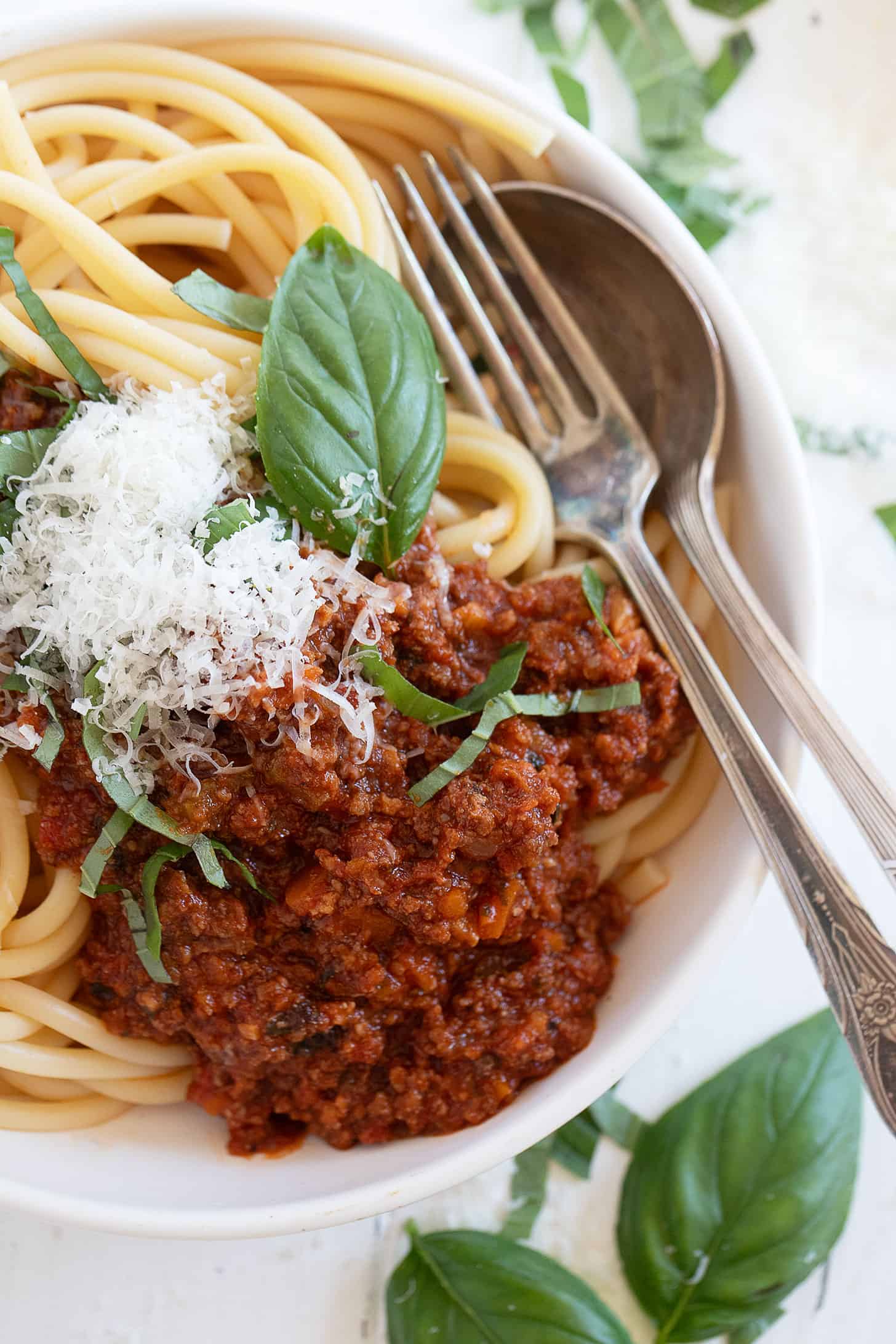
Storing and freezing
The cooked meat sauce will keep well in an airtight container in the refrigerator for 2-3 days.
This meat sauce will freeze beautifully! In fact, you don’t even need to thaw it. Simply add the frozen sauce to a saucepan and heat over low heat to thaw and serve.
Tip! Make a double batch and freeze some. As long as you have a bit enough pot to hold it all, you can use the same long-simmering time to make extra to put in the freezer. Portion it in “meal-sized” packages, so you’ll always have a quick and easy meal at the ready. Just add pasta!
Want to save this recipe?
Enter your email and I’ll send it to your inbox. Plus, you’ll get great new recipes from me every week!
By submitting this form, you consent to receive emails from Seasons and Suppers.
You can unsubscribe at any time.
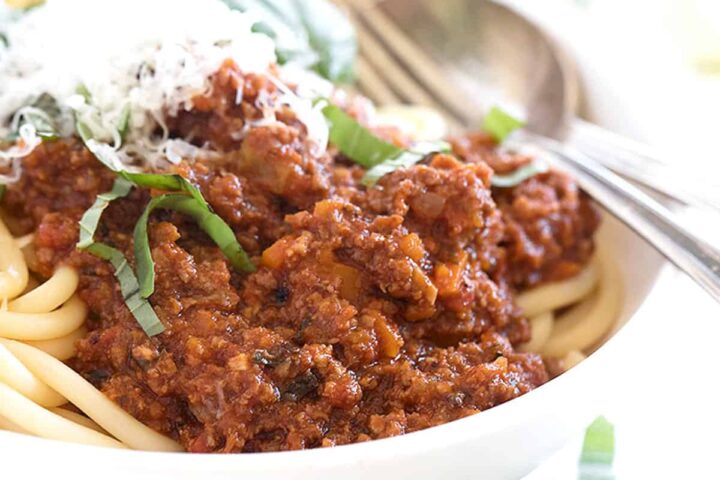
Get the Recipe: Classic Italian Meat Sauce
Ingredients
- 1 lb ground beef, or a mix of ground beef, pork and or/veal
- 2 Tablespoons extra virgin olive oil, divided
- 1 cup onion, diced
- 1/2 cup carrot, finely diced
- 1/2 cup celery, finely diced
- Pinch red pepper flakes, optional
- 4-5 cloves garlic, thinly sliced
- 1/4 cup tomato paste
- 1 cup red wine
- 28 oz whole canned tomatoes, hand-crushed
- 1/2 cup water
- 1/2 cup basil leaves, chopped, loosely packed or 2 Tbsp dried basil leaves
- 1 teaspoon dried oregano leaves
- 1-2 Tablespoon brown sugar, to taste
- 2 teaspoons salt
To finish:
- 1/4 cup heavy cream
- 2 Tablespoons butter
- Salt and freshly ground pepper, to taste
Instructions
- In a large, heavy-bottomed pot (such as a Dutch oven), heat 1 Tbsp olive oil over medium heat. Add the ground beef and cook over medium heat, stirring as necessary, until cooked through. Using a spoon, spoon of most of the fat/liquid in the pot and then continue cooking the ground beef to brown nicely. Remove ground beef to a bowl and set aside.
- Add the remaining 1 Tbsp olive oil to the same pot and heat over medium heat. Add the onion, carrot and celery to the pot and cook, stirring, until the onion is softened, 4-5 minutes. Add the red pepper flakes (if using) and the garlic and cook, stirring, about 1 minute more (don't let the garlic scorch). Add the tomato paste to the pot and cook, stirring, for another 1 minute. Add the red wine, stir, then allow to cook/simmer for about 2 minutes, or until reduced by about half. Add the canned tomatoes, water, basil leaves, oregano, brown sugar and salt. Stir well to combine. Return the cooked ground beef to the pot.
- Bring the mixture to a boil, then reduce the heat to medium low and simmer for about 2 hours, stirring regularly and more frequently as the mixture starts to thicken. (*Important to watch closely and stir often as sauce thickens, as the sauce/meat can scorch if is sits on the bottom of the pan in the thicker sauce.) Cook sauce until desired thickness reached. For pasta, I like to leave it a touch thinner. For lasagna or other baked pasta, you can cook until most of the liquid has cooked off.
- Add the heavy cream and butter to the sauce and cook, stirring until combined and warmed through. Taste the sauce and add additional salt and/or freshly ground pepper, as needed.
- *If desired, you can blend the sauce ever so slightly with a few blitzes with an immersion blender at this point, to blend the onion/carrots into the sauce. This is not necessary, just personal preference if you prefer a chunky or smooth sauce.
- Use sauce immediately or cool a bit, then refrigerate or freeze.
Notes
More Italian recipes to love!
Hi! I’m Jennifer, a home cook schooled by trial and error and almost 40 years of getting dinner on the table! I love to share my favourite recipes, both old and new, together with lots of tips and tricks to hopefully help make your home cooking enjoyable, stress free, rewarding and of course, delicious!


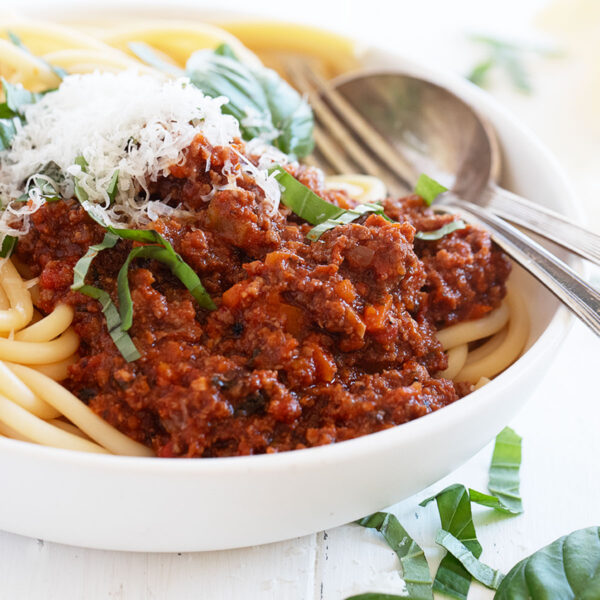
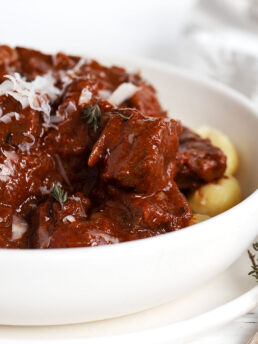
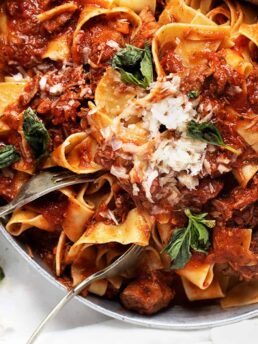
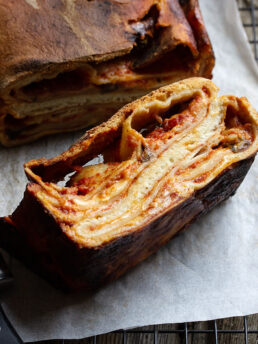

Hi Jennifer .. I am once again making this amazing sauce and am going to double the recipe but noticed that the amount of dried basil in the 2x is the same amount as it is the 1x .. assuming that I should double this amount as well ??
Hi Randy, I replied below for you, but yes, double that amount as well. Any amounts in the small notes will not automatically double. Enjoy :)
Thank you for your reply !!
Hi Jennifer .. me again .. lol I am now going to make a double batch of this amazing sauce but noticed that the amount of dried basil leaves are the same amount called for in the 1X recipe .. assuming that I should double this amount ?
Hi Randy and yes, use 4 Tbsp (1/4 cup) of the dried basil leaves for doubling. Only the amounts at the front of the ingredient will double with the calculator and not any amounts in the small print notes.
Simply put “Outstanding” …… enough said !
So glad you enjoyed it, Randy :) Thanks so much!
Hadn’t made a meat sauce for years, and this recipe caught my eye. This is exactly how my dad made sauce, and it was not only delicious but filled my kitchen with the most wonderful aroma. Made a double batch to freeze some and it will bring us some wonderful meals this fall. Thank you!
So glad to hear, Julie :) Thanks so much!
Not made meat sauce for decades, so this is the one! I always add a pinch of cinnamon to Italian tomato anything. Hubby will love the chili flakes.
Txs, Jennifer!
Do enjoy, Jettie :) Love the touch of cinnamon. Thanks!
Can you put this sauce in Masson jars instead of freezing it.
Hi Andrée, I’m afraid I can’t advise on this, as I’m not a master canner. I suggest you seek out some expert guidance on this, to ensure it is done safely.
Made this 2 days ago and it is delicious. I doubled it and it was a bit too sweet. Just added half a jar on Rao’s marinara and it was perfect. Will make it again
So glad you enjoyed it, Nancy :) Thanks!
Made this yesterday and doubled the sauce to freeze for leftovers. Absolutely our new fave spaghetti sauce. Amazing! Just have a quick question, when do you athdd the water? With the tomatoes? WIll make this again and again!
So glad you enjoyed it, Rachel and yes, the water goes in with the tomatoes (sorry, missed it in the instructions but have added it now :) I actually add the 1/2 cup water to the empty can of tomatoes and swish it around the can, then add to the pot, to get any extra bits of tomato left in the can, as well. Thanks!
Amazing flavour! Used a jarred garlic puree with capers to save some time. Got raves from picky husband!
Glad to hear! Thanks :)
Easy to make once ingredients are prepped. Superb flavour. I used san marzano tomatoes
So glad you enjoyed it, Elizabeth! Thanks :)
Cannot beat the classic recipes for sure! They are classic for a reason, right? Yours looks soo perfect – I see a few batches in my near future. Would also love to freeze some for quick dinners later on.
Thanks Milena and yes, I’m always thankful for the extra in the freezer, for those nights when I’m out of energy :)
This looks and sounds amazing, Jennifer! I love the additions of brown sugar, cream and butter. Not the norm but I know those add wonderful flavor. You’ve got me in an Italian mood now!
Thanks Chris :)
Can’t beat a classic Jennifer. This is one of my son Casey’s favorites. Can’t wait to try your recipe!
Thanks Mary Ann!
Great tip about the garlic Jennifer! And I love that you use carrots and plenty of red wine in this sauce. Another terrific recipe my husband would adore with all that luscious meat :)
Thanks so much, Tricia :)
Homemade meat sauce is always a hit in our house. This one looks thick and chunky. Pasta is usually a go to for us when we entertain, so I’m totally seeing this sauce on top of some spaghetti in our future!
Thanks Leanne!